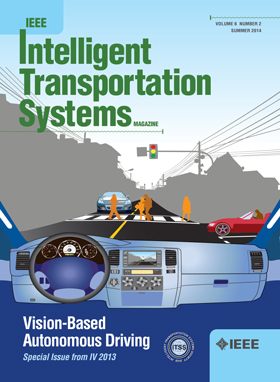自动驾驶汽车自然驾驶环境分布一致性仿真研究
IF 8.4
1区 工程技术
Q1 ENGINEERING, CIVIL
IEEE Transactions on Intelligent Transportation Systems
Pub Date : 2025-06-02
DOI:10.1109/TITS.2025.3571966
引用次数: 0
摘要
微观交通模拟为自动驾驶汽车提供了一个可控、可重复、高效的测试环境。为了公正地评价自动驾驶汽车的安全性能,需要模拟自然驾驶环境(NDE)中环境统计量的概率分布与真实驾驶环境的概率分布保持一致。然而,尽管人类驾驶行为在交通工程领域得到了广泛的研究,但现有的大多数模型都是为了分析交通流而开发的,没有考虑驾驶行为的分布一致性,这可能会导致自动驾驶汽车测试的评估偏差。为了填补这一研究空白,本文提出了一种分布一致的NDE建模框架。利用大规模自然驾驶数据,获得经验分布,构建不同条件下的随机驾驶行为模型。为了解决仿真过程中的误差积累问题,进一步设计了一种基于优化的方法来完善经验行为模型。具体而言,将车辆状态演化建模为马尔可夫链,并扭曲其平稳分布以匹配真实驾驶环境的分布。以多车道公路驾驶仿真为例,对该框架进行了评估,验证了生成的NDE分布的准确性,并对自动驾驶汽车模型的安全性能进行了有效评估。本文章由计算机程序翻译,如有差异,请以英文原文为准。
Distributionally Consistent Simulation of Naturalistic Driving Environment for Autonomous Vehicle Testing
Microscopic traffic simulation provides a controllable, repeatable, and efficient testing environment for autonomous vehicles (AVs). To evaluate AVs’ safety performance unbiasedly, the probability distributions of environment statistics in the simulated naturalistic driving environment (NDE) need to be consistent with those from the real-world driving environment. However, although human driving behaviors have been extensively investigated in the transportation engineering field, most existing models were developed for traffic flow analysis without considering the distributional consistency of driving behaviors, which could cause significant evaluation biasedness for AV testing. To fill this research gap, a distributionally consistent NDE modeling framework is proposed in this paper. Using large-scale naturalistic driving data, empirical distributions are obtained to construct the stochastic human driving behavior models under different conditions. To address the error accumulation problem during the simulation, an optimization-based method is further designed to refine the empirical behavior models. Specifically, the vehicle state evolution is modeled as a Markov chain and its stationary distribution is twisted to match the distribution from the real-world driving environment. The framework is evaluated in the case study of a multi-lane highway driving simulation, where the distributional accuracy of the generated NDE is validated and the safety performance of an AV model is effectively evaluated.
求助全文
通过发布文献求助,成功后即可免费获取论文全文。
去求助
来源期刊

IEEE Transactions on Intelligent Transportation Systems
工程技术-工程:电子与电气
CiteScore
14.80
自引率
12.90%
发文量
1872
审稿时长
7.5 months
期刊介绍:
The theoretical, experimental and operational aspects of electrical and electronics engineering and information technologies as applied to Intelligent Transportation Systems (ITS). Intelligent Transportation Systems are defined as those systems utilizing synergistic technologies and systems engineering concepts to develop and improve transportation systems of all kinds. The scope of this interdisciplinary activity includes the promotion, consolidation and coordination of ITS technical activities among IEEE entities, and providing a focus for cooperative activities, both internally and externally.
 求助内容:
求助内容: 应助结果提醒方式:
应助结果提醒方式:


